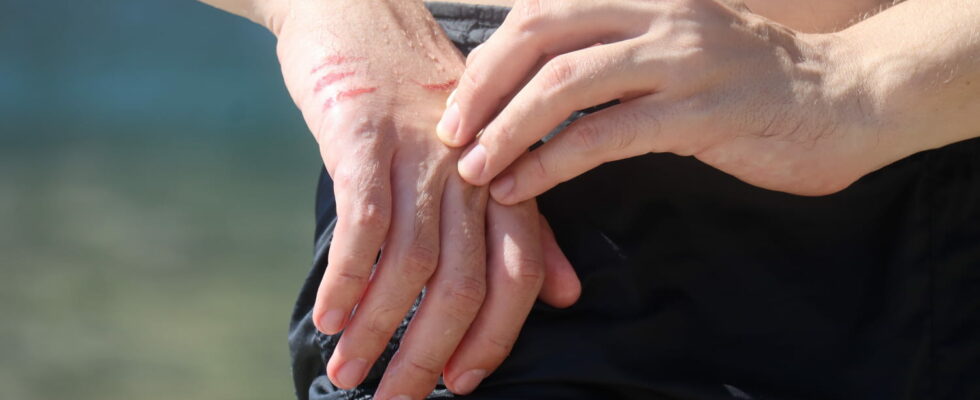If stung, the burning sensation is immediate.
Jellyfish live in seas and oceans all over the world. In France, we are particularly exposed to them in the Mediterranean during the summer. They can cause violent reactions in people who are stung. “Jellyfish do not cause a “sting” per se, but rather a contact envenomation, informs Stéphane Gayet, infectious disease specialist. Jellyfish stings are quickly recognized by feeling the discharge, but also a particular contact just before, a little sticky. In addition, they are easily seen: they generally swim on the surface of the water and in colonies. When you come into contact with a jellyfish, it causes:
- an immediate burning sensation, much like an electric shock, due to its venom. Maximum pain is estimated to occur between 20 and 30 minutes after being stung.
- red skin lesions, similar to nettle patches
- after a few days, “vesicles appear, like small bubbles with liquid inside”. It is important not to burst them to limit the risk of infection. This can persist for a few weeks.
What to do right away?
The first thing to do is to get out of the water and go to the shade to rest.
► Remove any filaments that may have stuck to the skin, using a glove or tweezers.
► Rinse the lesion thoroughly with sea water (not fresh water as this will cause the filaments to burst). Rinsing also helps to detach the filaments: “After a jellyfish burn, there are small invisible cells left on the skin, which continue to deliver venom. You must therefore rinse to remove them. You should not disinfect with medical alcohol, because there are too many lesions.”explains Stéphane Gayet, infectious disease specialist
► If possible, “you can possibly add vinegar water or lemon water, well diluted”advises the specialist. “Both are acids, which improve the condition of the sting a little, but apart from that, there is nothing to be done.”he adds.
► You can also apply a cream such as Biafine® to soothe the burn, or a cortisone cream to relieve larger patches. The most important thing is to rest and touch as little as possible.
►If you feel unwell or experience continued swelling, do not hesitate to contact a doctor. If the sting is on the face, immediately rinse your eyes with saline solution and seek emergency medical attention.
What remedies can be used for a jellyfish sting?
After rinsing the sting well with sea water and removing the filaments with tweezers, you can try a choice :
- Well diluted vinegar water
- Well diluted lemon water
- Lavender aspic essential oil: dab the burning area with a few drops and repeat every 10 minutes 3 to 5 times in a row.
Should you urinate on a jellyfish sting?
Forget the old wives’ tale of urinating on the area burned by a jellyfish sting, it is useless and can even make the situation worse.
Photo of a jellyfish sting
The most significant risk from a jellyfish sting is the venom projection into the eye: “It can burn the conjunctiva of the eye”, explains the specialist. “So you shouldn’t bother poking them with a stick, because that will spray venom. You just have to move away from them when you see one.” The other risk is to confuse the jellyfish with its cousin: the physalia. Its nickname is the “Portuguese galley”. It is mainly present in warm seas like the Mediterranean. “It’s not a jellyfish, but it looks like one: it’s a kind of big transparent pocket, floating on the surface of the water, inflated with air, with filaments, like the jellyfish”describes Stéphane Gayet. But this one is much more dangerous: “A venom discharge can lead to loss of consciousness resulting in drowning, whereas this is not the case with a jellyfish,” he explains. The jellyfish, however, is only really dangerous in groups, when you are stung several times.
What to do if you are allergic to a jellyfish sting?
If headaches, vomiting or respiratory discomfort (difficulty breathing) occur, it may be an allergy to the jellyfish “venom”. You should consult a doctor immediately.
What is the risk of scarring in the event of a jellyfish sting?
In the best case scenario, the lesions disappear within 10 days. A scar may persist, but disappear within a few months. It all depends on the depth of the burn, which is why taking the right steps after a sting (removing the filaments, rinsing for several minutes, etc.) is important to stop the arrival of venom quickly.
Thanks to Stéphane Gayet, infectious disease specialist.
- Essential oils, they work! Danièle Festy, Leduc editions, 2015.
